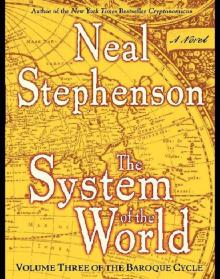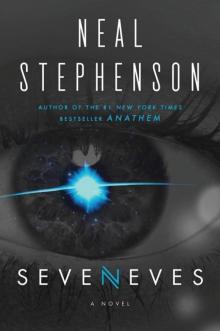- Home
- Neal Stephenson
Some Remarks: Essays and Other Writing Page 17
Some Remarks: Essays and Other Writing Read online
Page 17
Wildman Whitehouse predicted that sending bits down long undersea cables was going to be easy (the degradation of the signal would be proportional to the length of the cable) and William Thomson predicted that it was going to be hard (proportional to the length of the cable squared). Naturally, they both ended up working for the same company at the same time.
Whitehouse was a medical doctor, hence working in the wrong field, and probably trailed Thomson by a good 50 or 100 IQ points. But that didn’t stop Whitehouse. In 1856, he published a paper stating that Thomson’s theories concerning the proposed transatlantic cable were balderdash. The two men got into a public argument, which became extremely important in 1858 when the Atlantic Telegraph Company laid such a cable from Ireland to Newfoundland: a copper core sheathed in gutta-percha and wrapped in iron wires.
This cable was, to put it mildly, a bad idea, given the state of cable science and technology at the time. The notion of copper as a conductor for electricity, as opposed to a downspout material, was still extraordinary, and it was impossible to obtain the metal in anything like a pure form. The cable was slapped together so shoddily that in some places the core could be seen poking out through its gutta-percha insulation even before it was loaded onto the cable-laying ship. But venture capitalists back then were a more rugged—not to say crazy—breed, and there can be no better evidence than that they let Wildman Whitehouse stay on as the Atlantic Telegraph Company’s chief electrician long after his deficiencies had become conspicuous.
The physical process of building and laying the cable makes for a wild tale in and of itself. But to do it justice, I would have to double the length of this already herniated article. Let’s just say that after lots of excitement, they put a cable in place between Ireland and Newfoundland. But for all of the reasons mentioned earlier, it hardly worked at all. Queen Victoria managed to send President Buchanan a celebratory message, but it took a whole day to send it. On a good day, the cable could carry something like one word per minute. This fact was generally hushed up, but the important people knew about it—so the pressure was on Wildman Whitehouse, whose theories were blatantly contradicted by the facts.
Whitehouse convinced himself that the solution to their troubles was brute force—send the message at extremely high voltages. To that end, he invented and patented a set of 5-foot-long induction coils capable of ramming 2,000 volts into the cable. When he hooked them up to the Ireland end of the system, he soon managed to blast a hole through the gutta-percha somewhere between there and Newfoundland, turning the entire system into useless junk.
Long before this, William Thomson had figured out, by dint of Fourier analysis, that incoming bits could be detected much faster by a more sensitive instrument. The problem was that instruments in those days had to work by physically moving things around, for example, by closing an electromagnetic relay that would sound a buzzer. Moving things around requires power, and the bits on a working transatlantic cable embodied very little power. It was difficult to make a physical object small enough to be susceptible to such ghostly traces of current.
Thomson’s solution (actually, the first of several solutions) was the mirror galvanometer, which incorporated a tiny fleck of reflective material that would twist back and forth in the magnetic field created by the current in the wire. A beam of light reflecting from the fleck would swing back and forth like a searchlight, making a dim spot on a strip of white paper. An observer with good eyesight sitting in a darkened room could tell which way the current was flowing by watching which way the spot moved. Current flowing in one direction signified a Morse code dot, in the other a dash. In fact, the information that had been transmitted down the cable in the brief few weeks before Wildman Whitehouse burned it to a crisp had been detected using Thomson’s mirror galvanometer—though Whitehouse denied it.
After the literal burnout of the first transatlantic cable, Wildman Whitehouse and Professor Thomson were grilled by a committee of eminent Victorians who were seriously pissed off at Whitehouse and enthralled with Thomson, even before they heard any testimony—and they heard a lot of testimony.
Whitehouse disappeared into ignominy. Thomson ended up being knighted and later elevated to a baron by Queen Victoria. He became Lord Kelvin and eventually got an important unit of measurement, an even more important law of physics, and a refrigerator named after him.
Eight years after Whitehouse fried the first, a second transatlantic cable was built to Lord Kelvin’s specifications with his patented mirror galvanometers at either end of it. He bought a 126-ton schooner yacht with the stupendous amount of money he made from his numerous cable-related patents, turned the ship into a floating luxury palace and laboratory for the invention of even more fantastically lucrative patents. He then spent the rest of his life tooling around the British Isles, Bay of Biscay, and western Mediterranean, frequently hosting Dukes and continental savants who all commented on the nerd-lord’s tendency to stop in the middle of polite conversation to scrawl out long skeins of equations on whatever piece of paper happened to be handy.
Kelvin went on to design and patent other devices for extracting bits from the ends of cables, and other engineers went to work on the problem, too. By the 1920s, the chore of translating electrical pulses into letters had been largely automated. Now, of course, humans are completely out of the loop.
The number of people working in cable landing stations is probably about the same as it was in Kelvin’s day. But now they are merely caretakers for machines that process bits about as fast as a billion telegraphers working in parallel.
THE HACKER TOURIST TRAVELS TO THE LAND OF THE RISING SUN. TECHNOLOGICAL WONDERS OF MODERN CABLE STATIONS. WHY UGANDANS COULD NOT PLACE TELEPHONE CALLS TO SEATTLE. TRAWLERS, TICKLER CHAINS, TEREDO WORMS, AND OTHER HAZARDS TO UNDERSEA CABLES. THE IMMENSE FINANCIAL STAKES INVOLVED—WHY CABLE OWNERS DO NOT CARE FOR THE COMPANY OF FISHERMEN, AND VICE VERSA.
35˚ 17.690' N, 139˚ 46.328' E KDD Cable Landing Station, Ninomiya, Japan
Whether they are in Thailand, Egypt, or Japan, modern cable landing stations have much in common with each other. Shortly after touching down in Tokyo, we were standing in KDD’s landing station in Ninomiya, Japan. I’ll describe it to you.
A surprising amount of space in the station is devoted to electrical gear. The station must not lose power, so there are two separate, redundant emergency generators. There is also likely to be a transformer to supply power to the cable system. We think of optical fibers as delicate strands consuming negligible power, but all of those repeaters, spaced every few dozen kilometers across an ocean, end up consuming a lot of juice: for a big transoceanic cable, one or two amperes at 7,000 or so volts, for a total of something like 10,000 watts. The equipment handling that power makes a hum you can feel in your bones, kicking the power out not along wires but solid copper bars suspended from the ceiling, with occasional sections of massive braided metal ribbon so they won’t snap in an earthquake.
The emergency generators are hooked into a battery farm that fills a room. The batteries are constantly trickle-charged and exist simply to provide power during an emergency—after the regular power goes out but before the generators kick in. Most of the equipment in the cable station is computer gear that demands a stable temperature, so there are two separate, redundant air-conditioning plants feeding into a big system of ventilation ducts. The equipment must not get dirty or get fried by sparks from the fingers of hacker tourists, so you leave your shoes by the door and slip into plastic antistatic flip-flops. The equipment must not get smashed up in earthquakes, so the building is built like a brick shithouse.
The station is no more than a few hundred meters from a beach. Sandy beaches in out-of-the-way areas are preferred. The cable comes in under the sand until it hits a beach manhole, where it continues through underground ducts until it comes up out of the floor of the cable station into a small, well-secured room. The cable is attached to something big and strong, such as a massive steel grid bolted into
the wall. Early cable technicians were sometimes startled to see their cables suddenly jerk loose from their moorings inside the station—yanking the guts out of expensive pieces of equipment—and disappear in the direction of the ocean, where a passing ship had snagged them.
From holes in the floor, the cables pass up into boxes where all the armor and insulation are stripped away from them and where the tubular power lead surrounding the core is connected to the electrical service (7,500 volts in the case of FLAG) that powers the repeaters out in the middle of the ocean. Its innards then continue, typically in some kind of overhead wiring plenum (a miniature catwalk suspended from the ceiling) into the Big Room Full of Expensive Stuff.
The Big Room Full of Expensive Stuff is at least 25 meters on a side and commonly has a floor made of removable, perforated plates covering plenums through which wires can be routed, an overhead grid of open plenums from which wires descend like jungle vines, or both. Most of the room is occupied by equipment racks arranged in parallel rows (think of the stacks at a big library). The racks are tall, well over most people’s heads, and their insides are concealed and protected by face plates bearing corporate logos: AT&T, Alcatel, Fujitsu. In the case of an optical cable like FLAG, they contain the Light Terminal: the gear that converts the 1,558-nanometer signal lasers coming down the fiber strands into digits within an electrical circuit, and vice versa. The Light Terminal is contained within a couple of racks that, taken together, are about the size of a refrigerator.
All the other racks of gear filling the room cope with the unfathomable hassles associated with trying to funnel that many bits into and out of the fiber. In the end, that gear is, of course, connected to the local telecommunications system in some way. Hence one commonly sees microwave relay towers on top of these buildings and lots of manholes in the streets around them. One does not, however, see a lot of employees, because for the most part this equipment runs itself. Every single circuit board in every slot of every level of every rack in the whole place has a pair of copper wires coming out of it to send an alarm signal in the event that the board fails. Like tiny rivulets joining together into a mighty river, these come together into bundles as thick as your leg that snake beneath the floor plates to an alarm center where they are patched into beautiful rounded clear plastic cases enclosing grids of interconnect pins. From here they are tied into communications lines that run all the way to Tokyo so that everything on the premises can be monitored remotely during nights and weekends. Ninomiya is staffed with nine employees and Miura, FLAG’s other Japanese landing point, only one.
With one notable exception, the hacker tourist sees no particular evidence that any of this has the slightest thing to do with communications. It might as well be the computer room at a big university or insurance company. The one exception is a telephone handset hanging on a hook on one of the equipment racks. The handset is there, but there’s no keypad. Above it is a sign bearing the name of a city far, far away. “Ha, ha!” I said, the first time I saw one of these, “that’s for talking to the guy in California, right?” To my embarrassment, my tour guides nodded yes. Each cable system has something called the order wire, which enables the technicians at opposite ends of the cable to talk to each other. At a major landing station you will see several order wires labeled with the names of exotic-sounding cities on the opposite side of the nearest large body of water.
That is the bare minimum that you will see at any cable station. At Ninomiya you see a bit more, and therein lies something of a tale.
Ninomiya is by far the oldest of KDD’s seven cable landing stations, having been built in 1964 to land TPC–1, which connected Japan to Guam and hence to the United States. Unlike many of FLAG’s other landing sites, which are still torn up by backhoe tracks, it is surrounded by perfectly maintained gardens marred only by towering gray steel poles with big red lights on them aimed out toward the sea in an attempt to dissuade mariners from dropping anchor anywhere nearby. Ninomiya served as a training ground for Japanese cable talent. Some of the people who learned the trade there are among the top executives in KDD’s hierarchy today.
During the 1980s, when Americans started to get freaked out about Japan again, we heard a great deal about Japanese corporations’ patient, long-term approach to R&D and how vastly superior it was to American companies’ stupid, short-term approach. Since American news media are at least as stupid and short-term as the big corporations they like to bitch about, we have heard very little follow-up to such stories in recent years, which is kind of disappointing because I was sort of wondering how it was all going to turn out. But now the formerly long-term is about to come due.
By the beginning of the 1980s, the generation of cable-savvy KDD men who had cut their teeth at Ninomiya had reached the level where they could begin diverting corporate resources into R&D programs. Tohru Ohta, who today is the executive vice president of KDD, managed to pry some money loose and get it into the hands of a protégé, Dr. Yasuhiko Niiro, who launched one of those vaunted far-sighted Japanese R&D programs at Ninomiya. The terminal building for TPC–1, which had been the center of the Japanese international telecommunications network in 1964, was relegated to a laboratory for Niiro. The goal was to make KDD a player in the optical-fiber submarine cable manufacturing business.
Such a move was not without controversy in the senior ranks of KDD, who had devoted themselves to a very different corporate mission. In 1949, when Japan was still being run by Douglas MacArthur and the country was trying to dig out from the rubble of the war, Nippon Telephone & Telegraph (NT&T) split off its international department into a new company called Kokusai Denshin Denwa Co., Ltd. (KDD), which means International Telegraph & Telephone. KDD was much smaller and more focused than NT&T, and this was for a reason: Japan’s international communications system was a shambles, and nothing was more important to the country’s economic recovery than that it be rehabilitated as quickly as possible. The hope was that KDD would be more nimble and agile than its lumbering parent and get the job done faster.
This strategy seems to have more or less worked. Obviously, Japan has succeeded in the world of international business. It is connected to the United States by numerous transpacific cables; lines to the outside world are plentiful. Of course, since KDD enjoyed monopoly status for a long time, the fact that these lines are plentiful has never led to their being cheap. Still, the system worked. Like much else that worked in Japan’s postwar economy, it succeeded, in those early years, precisely insofar as it worked hand-in-glove with American companies and institutions. AT&T, in other words.
Unlike the United States or France or Great Britain, Japan was never much of a player in the submarine cable business back in the prewar days, and so Ohta’s and Niiro’s notion of going into head-to-head competition against AT&T, its postwar sugar daddy, might have seemed audacious. KDD had customarily been so close to AT&T that many Japanese mocked it cruelly. AT&T is the sumo champion, they said, and KDD is its koshi-ginchaku, its belt-holding assistant. The word literally means waist purse but seems to have rude connotations along the lines of jockstrap carrier.
Against all of that, the only thing that Ohta and Niiro had to go on was the fact that their idea was a really, really good one. Building cables is just the kind of thing that Japanese industry is good at: a highly advanced form of manufacturing that requires the very best quality control. Cables and repeaters have to work for at least 25 years under some really unpleasant conditions.
KDD Submarine Cable Systems (KDD-SCS) built its first optical fiber submarine cable system, TPC–3, in 1989 and will soon have more than 100,000 kilometers of cable in service worldwide. It designs and holds the patents on the terminal equipment that we saw at Ninomiya, though the equipment itself is manufactured by electronics giants like Toshiba and NEC. KDD-SCS is building some of the cable and repeaters that make up FLAG, and AT&T-SSI is building the rest. A problem has already surfaced in the AT&T repeaters—they switched to a different soldering technique which
turns out to be not such a good idea. Eleven of the repeaters that AT&T made for FLAG have this problem, and all of them are lying on the bottom of oceans with bits running through them—for now. FLAG and AT&T are still studying this problem and trying to decide how to resolve it. Still, everyone in the cable business knows what happened—it has to be considered a major win for KDD-SCS.
So when KDD threw some of its resources into one of those famous far-sighted long-range Japanese R&D programs, it paid off beautifully. In the field of submarine cable systems, the lowly assistant has taught the sumo champion a lesson and sent him reeling back—not quite out of the ring, but certainly enough to get his attention. How, you might ask, is the rest of KDD doing?
The answer is that, like most other PTTs, it’s showing its age. Even the tactful Japanese are willing to admit that they have performed poorly in the world of international telecommunications compared to other countries. Non-Japanese will tell you the same thing more enthusiastically.
The telco deregulation wars have begun in Japan as they have almost everywhere else, and KDD now has competitors in the form of International Digital Communications Inc. (IDC), which owns the Miura station, the other FLAG landing spot. In order to succeed in this competition, KDD needs to invest a lot of money, but the very smallness that made it such a good idea in 1949 puts it at a disadvantage when large amounts of capital are needed.
Just as Ninomiya is a generic cable landing, so KDD is something of a generic PTT, facing many of the same troubles that others do. For example: the Japanese telecommunications ministry continues to set rates at an artificially high level. At first blush, this would seem to help KDD by making it much more difficult for upstarts like IDC to compete with them. But in fact it has opened the door to an unexpected form of competition: callback.

 Zodiac: The Eco-Thriller
Zodiac: The Eco-Thriller The Mongoliad: Book One
The Mongoliad: Book One Snow Crash
Snow Crash The Confusion: Volume Two of the Baroque Cycle
The Confusion: Volume Two of the Baroque Cycle The Rise and Fall of D.O.D.O.
The Rise and Fall of D.O.D.O. The Diamond Age: Or, a Young Lady's Illustrated Primer
The Diamond Age: Or, a Young Lady's Illustrated Primer The Big U
The Big U The System of the World: Volume Three of the Baroque Cycle
The System of the World: Volume Three of the Baroque Cycle The Cobweb
The Cobweb Reamde
Reamde Fall; or, Dodge in Hell
Fall; or, Dodge in Hell Interface
Interface Quicksilver
Quicksilver The Mongoliad: Book Three
The Mongoliad: Book Three Seveneves
Seveneves Atmosphæra Incognita
Atmosphæra Incognita In the Beginning...Was the Command Line
In the Beginning...Was the Command Line Anathem
Anathem The Rise and Fall of D.O.D.O.: A Novel
The Rise and Fall of D.O.D.O.: A Novel The Mongoliad: Book Two
The Mongoliad: Book Two Diamond Age or a Young Lady's Illustrated Primer
Diamond Age or a Young Lady's Illustrated Primer THE System OF THE WORLD
THE System OF THE WORLD The Mongoliad: Book One tfs-1
The Mongoliad: Book One tfs-1 Some Remarks: Essays and Other Writing
Some Remarks: Essays and Other Writing Zodiac
Zodiac Spew
Spew The Baroque Cycle: Quicksilver, the Confusion, and the System of the World
The Baroque Cycle: Quicksilver, the Confusion, and the System of the World The Diamond Age
The Diamond Age Reamde: A Novel
Reamde: A Novel In the Kingdom of Mao Bell
In the Kingdom of Mao Bell Mother Earth Mother Board
Mother Earth Mother Board Twelve Tomorrows - Visionary stories of the near future inspired by today's technologies
Twelve Tomorrows - Visionary stories of the near future inspired by today's technologies The Confusion
The Confusion The Great Simoleon Caper
The Great Simoleon Caper The Mongoliad: Book Three tfs-3
The Mongoliad: Book Three tfs-3